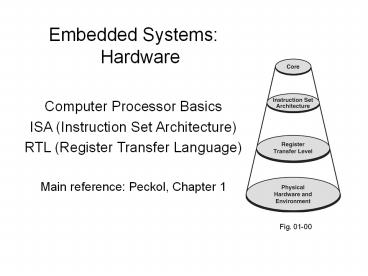Embedded Systems: Hardware - PowerPoint PPT Presentation
Title:
Embedded Systems: Hardware
Description:
Embedded Systems: Hardware Computer Processor Basics ISA (Instruction Set Architecture) RTL (Register Transfer Language) Main reference: Peckol, Chapter 1 – PowerPoint PPT presentation
Number of Views:201
Avg rating:3.0/5.0
Title: Embedded Systems: Hardware
1
- Embedded Systems Hardware
- Computer Processor Basics
- ISA (Instruction Set Architecture)
- RTL (Register Transfer Language)
- Main reference Peckol, Chapter 1
Fig. 01-00
2
fig_01_01
Basic components
Common bus structure address, data, control
fig_01_01
fig_01_03
3
fig_01_05
Some processor options (note firmware)
1. Microprocessor-based system
fig_01_05
2. Microcontroller-based system Fig. 1-05
components integrated into one unit)
fig_01_07
DSP (A/D, D/A high speedvideo, audio, images
fig_01_06
4
fig_01_08
DATA DATA TYPES
NUMERIC --Unsigned integer --Signed integer (2s
complement, sign-magnitude, fixed point,
etc.) --Floating point 3 components sign expon
ent mantissa
fig_01_08
NONNUMERIC --address --character
5
fig_01_09
- Numeric data
- Range is always limited. Number of digits of
resolution is size of fractional part. - Example in 4 numeric bits
- Number of bits in fraction range
- 0 (integer) 0-15
- 1 xxx.x 0-7.5
- (fractions 0, ½)
- 2 xx.xx 0-3.75
- (fractions, 0, ¼, ½, ¾)
- 3 x.xxx 0-1.875
- (fractions, 0, 1/8, ¼, 3/8, ½, 5/8, ¾, 7/8)
6
fig_01_09
Most base 10 fractions cannot be represented
exactly in binary Example how to represent 2.x
in 4 bits, with 2 bits of resolution? Choices
2.0, 2.25, 2.5, 2.75, 3.0 2.1 ? 2.0 or 2.25 2.2 ?
2.0 or 2.25 2.3 ? 2.0 or 2.25 or 2.5
fig_01_09
r
rounding
truncation
truncation
Error range for n bits of resolution Truncation
-2-n lt Etruncation lt 0 Rounding - ½ 2-n lt
Erounding lt ½ 2-n Computation which is easier
to compute?
rounding down
rounding up
7
fig_01_09
Error propagation in arithmetic Examples Conside
r two numbers whose true values are N1 and N2 and
whose values in the computing system are N1E and
N2E Addition errors add N1E N1 E1 N2E
N2 E2 N1E N2E (N1 E1) (N2
E2) N1 N2 E1
E2 Multiplication error N1E N2E (N1
E1) (N1 E2) (N1N2) (N2 E1 N1
E2) (E1 E2) term 1 term
2 Note that if term 2 is neglected then error
depends on size of N1 and N2
8
fig_01_10
Another example (pp. 11-12 of text) measuring
power dissipated in resistor R in the following
circuit Suppose E 100 VDC /- 1, I 10A
/- 1, R 10 ohms /- 1. 3 methods of
caluculatin power dissipated, neglecting lower
order error terms a. E1 (100V /- 1) (10A
/- 1) 998.9 ? 1001.1 b. I2R (10A /- 1)
(10A /- 1) (10 ohms /- 1) 997 ? 1003 c.
E3 (100 V /- 1)(100 V /- 1) / (10 ohms /-
1) 908.9 ? 1111.3 Which should we
use? optimistic a middle-of-the-road
average of a,b,c safest c
fig_01_10
9
- InstructionsISA level
- Instruction coding
- HLL (high level language, C, C , e.g.)
- assembly language (ISA)
- machine language
- (can work at any level high level allows faster
but less efficient coding) - IEEE Standard 694-1985IEEE standard for
microprocessor assembly languageused for
examples in text
10
operator addr mode operand(s)
Instruction coding Fields operator, operands
(type of addressing) Example 32 bits 3 bits
opcode 2 bits address mode (e.g. direct,
indirect, indexed, immediate) 27 bits for
addressing operand (s) Expanding opcode
(example) 000-110xxxxxxx 2 operands 1110xxxx
xx 1 operand 1111xxxxxx no operand (e.g.,
HALT)
11
fig_01_13
Example instruction formats
fig_01_14
fig_01_13
fig_01_15
12
Instructions Instruction types arithmetic /
logical data movement control Arithmetic /
logical instructions operator number of
operands arity (unary, binary, three-operand,
) Examples x -x negation, assignment x
y assignment x x y addition,
assignment z x y addition, assignment
13
fig_01_42
Typical ALU and registers
fig_01_42
14
fig_01_43
Common ALU functions
fig_01_43
Cannot be affected by interrupt
15
fig_01_44
Common ALU functions (continued)
fig_01_44
16
fig_01_45
Common ALU functions (continued) Question
what is a minimal set of ALU instructions?
fig_01_45
17
fig_01_16
Data movement instructions source / destination
fig_01_16
18
fig_01_17
Common data movement instructions
fig_01_17
Question how can you implement XCH without
using a temporary variable?
19
fig_01_12
Addressing modes Immediate MOVE A,
BH Direct MOVE OPR1, OPR2 Indirect MOVE
OPR1, myVarPtr MOVE OPR1, OPR1 MOVE
OPR1, yPtr Register direct MOVE Reg1,
Reg2 Register indirect MOVE Reg1,
Reg2 Indexed (loops) MOVE Reg1, OPR2REG2 PC
relative (loops,e.g. offset can be
negative) ADD PC, Reg1 Example what is
the difference between Y, Y, Y
fig_01_12
Indirect addressingmyVarPtr holds address or
myVar
20
fig_01_21
Addressing examples
fig_01_21
21
fig_01_22
fig_01_22
22
fig_01_23
fig_01_23
23
fig_01_24
fig_01_24
24
fig_01_25
Control instructions Control can be sequential
(default) loop (pre or posttest) branch go
to conditional (if, if-else,, case, branch on
condition) procedure or function calll
25
fig_01_29
Branch instructions Typical condition
codes Typical branch instructions
fig_01_29
fig_01_30
26
fig_01_31
Example of conditional statements C / assembly
language
fig_01_31
fig_01_32
27
fig_01_34
Looping example
fig_01_34
fig_01_35
28
fig_01_36
Function or procedure call Must store return
address, pass information back and
forth What are standard parameter
passing methods?
fig_01_36
fig_01_37
29
fig_01_39
Stack common way to handle procedure / function
calls Q what are two alternative methods
for handling function / procedure calls? Which
methods facilitate recursion?
fig_01_39
30
fig_01_40
Function call example
fig_01_40
fig_01_41
31
Question can you design a general-purpose
computer with a 3-bit opcode?
32
fig_01_46
Different viewpoint RTL register-transfer
language level
fig_01_46
33
fig_01_49
Register behavior Read / Write Serial / Parallel
fig_01_49
fig_01_51
fig_01_50
34
fig_01_52
RTL VIEW
fig_01_52
fig_01_53
35
fig_01_54
Instruction execution cycle Q Where is
this step implemented?
fig_01_55
fig_01_54
36
fig_01_57
Multiple levels--examples
fig_01_57
37
fig_01_58
fig_01_58
38
fig_01_59
fig_01_59
39
table_01_03
table_01_03

